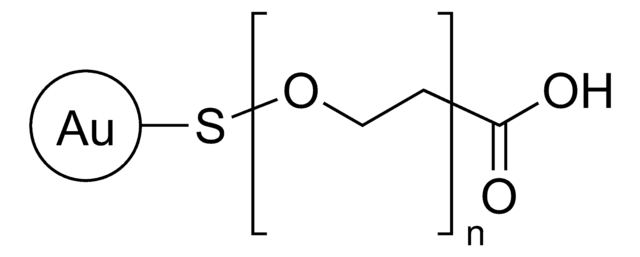Key Documents
765279
Gold nanoparticles
5 nm diameter, amine functionalized, PEG 5000 coated, OD 50, dispersion in H2O
Synonim(y):
Gold nanoparticles NH2 functionalized, Au NP NH2, Gold Colloid
About This Item
Polecane produkty
Materiały
PEG 5000
Poziom jakości
Postać
dispersion in H2O
nanoparticles
opakowanie
poly bottle of 1 mL
OD
50
średnica
5 nm
pH
6.0-8.0 (25 °C)
rozpuszczalność
water: miscible
gęstość
1.00 g/cm3
λmaks.
515 nm
grupa funkcyjna
amine
temp. przechowywania
2-8°C
Szukasz podobnych produktów? Odwiedź Przewodnik dotyczący porównywania produktów
Opis ogólny
Zastosowanie
- Since AuNPs adhere to cell membranes, they can be used in cellular and intracellular targeting in targeted drug delivery applications and may also be used in biodistribution studies
- AuNPs may also be used in photothermal therapy and radiotherapy.
- Proposed applications of gold nanoparticles are as:drug delivery agents for cancer therapy, coatings, plastics, nanowire, nanofiber, textiles, catalyst applications.
- They may also be used in carrying siRNA which acts against human prostate carcinoma cells by inhibiting a specific cancer gene.
Cechy i korzyści
- Negatively charged siRNA-PEG complex which is attached to positively charged GNPs is easily cleavable in reductive cytosolic environment thus enabling the release of siRNA into cytosol.
- Decreases the cytotoxicity and increases effciciency of GNPs. PEG increases the stability of the nanoparticles and prevents agglomeration.
Kod klasy składowania
12 - Non Combustible Liquids
Klasa zagrożenia wodnego (WGK)
WGK 2
Temperatura zapłonu (°F)
Not applicable
Temperatura zapłonu (°C)
Not applicable
Wybierz jedną z najnowszych wersji:
Certyfikaty analizy (CoA)
Nie widzisz odpowiedniej wersji?
Jeśli potrzebujesz konkretnej wersji, możesz wyszukać konkretny certyfikat według numeru partii lub serii.
Masz już ten produkt?
Dokumenty związane z niedawno zakupionymi produktami zostały zamieszczone w Bibliotece dokumentów.
Nasz zespół naukowców ma doświadczenie we wszystkich obszarach badań, w tym w naukach przyrodniczych, materiałoznawstwie, syntezie chemicznej, chromatografii, analityce i wielu innych dziedzinach.
Skontaktuj się z zespołem ds. pomocy technicznej




